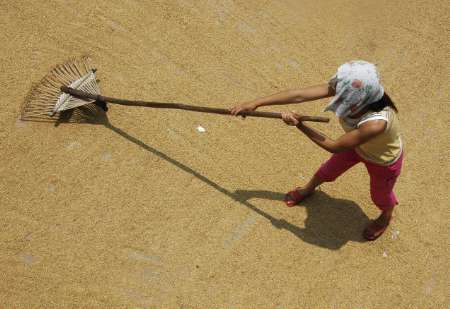Economy
Investment targets grain production
By Jin Zhu (China Daily)
Updated: 2010-12-23 11:27
 |
Large Medium Small |
A farmer suns grain on the outskirts of Yingtan, central China's Jiangxi province in this file photo taken in 2007. [Photo / Reuters]
Conference maps out policies for the development of rural regions

BEIJING - China has pledged to intensify its construction of rural infrastructure to boost the country's grain production, which is threatened by natural disasters and shrinking arable land.
More investment will be made in the construction of water conservation and other facilities in rural areas, according to a statement released after the two-day annual central rural work conference concluded on Wednesday.
The conference mapped out policies for next year's development of agriculture and rural regions.
Senior officials of the State Council, China's cabinet, and provincial-level officials attended the conference.
Minister of Agriculture Han Changfu said at the conference that boosting the country's grain production will be the primary task in 2011.
"China will maintain its grain planting acreage at above 107 million hectares next year and try to increase grain yield to ensure food supply," he said.
Despite floods and drought, the country's grain production will rise to 546.4 billion kilograms in 2010, an increase of 15.6 billion kg on last year, the seventh consecutive year of growth for China's grain output.
The minister said the increase in grain production this year is more than expected and supports the nation's overall economic growth.
| ||||
The central government has invested 828.3 billion yuan ($123.6 billion) to boost grain production and combat natural disasters like severe drought, low temperatures and floods - conditions that affected the nation's agricultural production in 2010.
"The investment may increase to 900 billion yuan next year, which will mainly focus on improving rural infrastructure construction, such as water conservation facilities," an agricultural expert, who declined to be named, was quoted as having said by 21st Century Business Herald on Wednesday.
More than 170 billion yuan will be invested for constructing water conservation projects in 2011, a 10 percent increase on this year, the report said.
Zhang Hulin, a professor at the Party School of the Communist Party of China Central Committee, told China Daily on Wednesday that although the government has been increasing its financial support for agriculture, the shortfall is still substantial.
"The current gap between urban and rural development is huge and that is impeding the country's future progress, so it is high time the government gave more support to rural areas," he said.
Han earlier warned that the country's agriculture risks "being ignored and weakened" over the next five years in the face of the country's rapid industrialization and urbanization.
"Besides giving financial support to build up the infrastructure in rural areas, the construction of roads and water treatment facilities should also be intensified to improve rural living conditions," Zhang said.
"The support policy should not be a temporary measure, but one that lasts into the future," he stressed.
Policymakers agreed earlier this month at the Central Economic Work Conference that the government will increase subsidies for agricultural production, steadily raise minimum grain purchase prices, and increase investment in major grain producing areas and water conservation facilities.
The ministry will work to increase output in six agricultural production areas next year: existing major grain-production areas; production areas of important agricultural products like cotton and rape; suburban farms; production bases in eastern coastal regions; large State-run farms in regions including the Xinjiang Uygur autonomous region and Heilongjiang and Guangdong provinces; as well as grasslands and pastoral areas.



